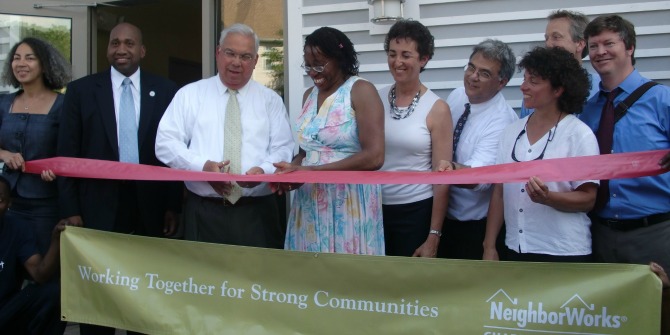

 The Great Recession and its aftermath have seen new challenges for many American cities. In new research, Pierre-Alexandre Balland, David Rigby and Ron Boschma look at why some cities are more resilient to challenges and crises than others. They write that cities vary in their response to technological crises because of differences in their socio-economic flexibility. They argue that cities which are able to deploy inventors to new developing technological activities are better placed to avoid crises, and to cope with them when they do occur.
The Great Recession and its aftermath have seen new challenges for many American cities. In new research, Pierre-Alexandre Balland, David Rigby and Ron Boschma look at why some cities are more resilient to challenges and crises than others. They write that cities vary in their response to technological crises because of differences in their socio-economic flexibility. They argue that cities which are able to deploy inventors to new developing technological activities are better placed to avoid crises, and to cope with them when they do occur.
Why are some cities able to survive major shocks, crises and sustained periods of decline while others ultimately collapse? In new research we examine the production of technological knowledge in the United States, finding that resilient cities are not necessarily the largest or those that experienced the fastest growth in the past: they are the cities able to adapt to changing economic, social and environmental conditions.
In a global context of financial turmoil, rising inequality and environmental uncertainty, the question of how cities overcome crises has become increasingly prominent on the scientific and political agenda. Understanding urban resilience requires a dynamic view of the economic structure of cities and questions simple logics of urban development as a finite process. By asking how cities continuously re-invent themselves and create new growth paths, we challenge urban policy to explore geographies of creative-destruction in which sustained growth rests upon the abandonment of obsolete sectors, modes of work organization and institutional practices.
Cities that fail to adapt and change, those that get locked-in to specific practices, ultimately decline. Resilient cities, on the contrary, are able to maintain their essential functionality through short-run shocks and over the long run. For many cities this functionality has evolved over time. Once sites of protection for the local population, cities today play a critical role as centers of knowledge production and innovation. As they agglomerate in space, individuals and firms exchange information, learn from each other and recombine knowledge more easily. Major technological-hubs in the United States such as San José, Boston and Austin host large numbers of creative individuals and are responsible for a large share of the nation’s new technologies. These cities are also among the richest, fastest growing metropolitan areas of the country.
We make use of patent data to explore the technological resilience of U.S. cities. The data produced by the United States Patent and Trademark Office (USPTO) includes all utility patents and identifies the names of inventors and the nature of new technologies along with information on the geography and history of knowledge production. The patent data are used to define technological crises as periods of sustained negative growth in patenting activity. Analysis of patented inventions in metropolitan areas from 1975 to 2005 shows that the frequency, intensity and duration of technological crises vary considerably across American cities. Why? Why are some cities almost always in crisis while others manage to avoid periods of decline? Why do some cities suffer more than others when hit by a shock? And why do some cities recover much faster from crisis than others?
Differences in the vulnerability and the response of cities to technological crises can be explained to a large extent by differences in their socio-economic flexibility. The most important factor here is technological flexibility. Technological flexibility indicates how well the skills of inventors in a city can be redeployed to new technological activities (those not yet developed in the city). Technological flexibility provides a measure of the potential reconfiguration of local technological skills and assets, a measure of the relative ease with which a city might adjust or adapt its technological portfolio in the face of shocks that might render parts of that portfolio less competitive. Cities with more technological flexibility have a higher tendency to avoid crises and a greater capacity to limit the intensity and duration of crisis events.
Credit: Justin Brown (Flickr, CC-BY-NC-SA-2.0)
Other socio-economic dimensions such as network flexibility and institutional flexibility seem to be less important. Network flexibility indicates how dependent inventors of a given cities are on inventors located in other cities. If knowledge can easily be accessed from different external sources, the city has high network flexibility. Institutional flexibility is based on the enforceability of non-competition agreements. Non-competition agreements are legal contracts that prevent the workers of one firm from joining a rival firm, including spin-offs that they might form themselves. As a result, non-competition agreements can reduce labor mobility and knowledge flows within cities, further reducing the capacity to adapt and change.
So what makes American cities resilient over time? An important element of response is that cities need a flexible socio-economic structure – in terms of skills, networks and institutions – to “re-invent” themselves and move from declining to emerging technological activities. Flexible socio-economic structures prevent lock-in by providing room for the process of creative destruction underlying urban resilience. This approach deeply challenges our understanding of the role of urban policy. If resilient cities are characterized by an intense process of creative-destruction, then sustained periods of growth require active transition policy to replace traditional jobs, sectors and technologies with new activities. This transition, by nature, conflicts with the interests of individuals and organizations in incumbent technologies or industries, as we witness today with the rise of the sharing economy.
In their fight for survival existing organizations might seek refuge through policy protections that are likely to slow adaptation and that may weaken the long-run resilience of cities. The challenge for policy-makers then is the creation of the set of institutions that provide and nurture spaces of urban creativity that build upon the sets of competencies and skills that are accumulated in cities ensuring that continual innovation supports growth for broad coalitions of economic agents.
This article is based on the paper, ‘The technological resilience of US cities’, in the Cambridge Journal of Regions, Economy and Society.
Please read our comments policy before commenting.
Note: This article gives the views of the author, and not the position of USAPP – American Politics and Policy, nor the London School of Economics.
Shortened URL for this post: http://bit.ly/1iNSBBq
_________________________________
 Pierre-Alexandre Balland – Utrecht University
Pierre-Alexandre Balland – Utrecht University
Pierre-Alexandre Balland is Assistant Professor in Economic Geography at Utrecht University, and research associate at CIRCLE, Lund University. He is fascinated by the mechanisms that lead to the emergence of new ideas and how societies create and exchange knowledge. His work focuses in particular on the persistent role of geographical proximity in a world that seems smaller than ever before.
 David Rigby – UCLA
David Rigby – UCLA
David Rigby is Professor of Geography and Statistics at UCLA. Trained in analytical political economy, his early work examined historical geographies of technology and economic performance. Interests in the heterogeneity of economic agents prompted a shift to exploration of plant and firm-level microdata and theoretical work in evolutionary economic geography. His current research explores geographies of knowledge production and knowledge flow.
 Ron Boschma – Lund University
Ron Boschma – Lund University
Ron Boschma is Professor in Innovation Studies and director of the Centre for Innovation, Research and Competence in the Learning Economy (CIRCLE) at Lund University. He is also Professor in Regional Economics at Utrecht University. His scientific work concentrates on working out conceptually and empirically Evolutionary Economic Geography. Boschma has published in international journals on the spatial evolution of industries, the geography of innovation, proximity and innovation, the structure and evolution of spatial networks, regional diversification, and agglomeration externalities and regional growth.







